It is hard to overrate the importance of books in a child’s life—especially those that tell a great story. Through such books, a child meets his first heroes, learns about the world as it is and as it should be, and falls in love with one of the great joys in life: reading.
As a parent of a five-year-old boy who loves to read and be read to, I have sampled a library of books. Some are no good, others very good, and many are in-between. The following twelve, however, are exceptional. All are set in a benevolent world, have interesting characters that your child will admire, and tell stories that engross and inspire. These stories also are enjoyable for parents, which is important because (if you have not discovered already) it is dangerous to read a young child a book that you’re not prepared to read many times. Happy reading!
Goodnight Moon by Margaret Wise Brown
Goodnight Moon is a classic of children’s literature.1 It is the one book almost everyone recommends, and for good reason. The book tells the story of a little rabbit observing many things in a “great green room” and then saying good night to them, one by one.
The language is melodic. There are little surprises that surprise every time and make rereading the book a joy. And the experience it provides both parent and child is one of serenity—the feeling that everything is in its proper place and all is well with the world.
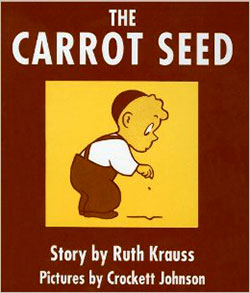 The Carrot Seed by Ruth Krauss
The Carrot Seed by Ruth Krauss
The Carrot Seed is another well-deserved classic.2 It tells the story of a little boy who plants a carrot seed and who continues to sprinkle the ground with water and pull up the weeds around it—despite his parents and his big brother saying that “nothing will come up.” The drama between this independent young boy and his family is resolved when the carrot seed finally does come up—“just as the boy had known it would.”
The book consists of just ten sentences, 101 words, but it tells a complete story with an important theme. The simple illustrations by Crockett Johnson further convey and dramatize the theme: thinking for yourself and working toward your goals can be difficult, but they pay—and sometimes big.
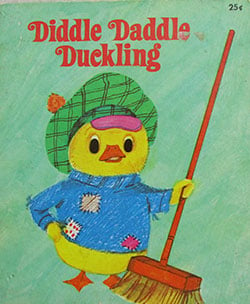 Diddle Daddle Duckling by Grace Irene Bennett
Diddle Daddle Duckling by Grace Irene Bennett
Diddle Daddle Duckling is not a classic, but it should be.3 It is out of print and almost completely unheard of. The only way to buy it is used—and given that it was first published in 1934, the used copies are likely to be in pretty bad shape. Our copy is held together by tape. Nevertheless, it is one of the best books for children I have ever read.
The hero of the story is a little yellow duckling named Diddle Daddle Duckling. He’s a poor duckling who has seven brothers and sisters, wears clothes that are full of patches, and wakes up one morning to an empty cupboard. Diddle Daddle responds to that discovery by putting on his hat and setting out to look for a job.
He knocks on the door of Mrs. Dog, saying, “Do you have any work? I want a job.” Told no, he waddles down the street to Mrs. Hen’s house, “holding his head high,” and asks her the same thing. Told no again, Diddle Daddle waddles on, sits on a rock to rest, and then gets up and tries once more.
This time, Diddle Daddle gets a job at Old Puddle Duck’s garage. He sweeps the floors so well that Old Puddle Duck says, “Well done, my boy!” He oils customer’s engines, pumps up their tires, and sells them gasoline. By the end of the day, Old Puddle Duck is impressed. And, in a line that brings a big smile to my son’s face every time, Old Puddle Duck says: “Come here my boy. Here is your money. You are a good worker. Come back tomorrow.”
The story goes on to show how Diddle Daddle spends his money on bread for his whole family, hears his mother tell him how proud she is of him, and—on the last page—falls asleep, “dreaming of buns and oilcans and watering cans.” In his sleep, and with a look of contentment on his face, he quacks, “I have a job!”
Like the previous book, and again despite being for children, this is real literature. It is serious, too. And my son loves it as much, if not more, than many of the more typical, less serious books mistakenly regarded by many adults as the only kind of books that interest children.
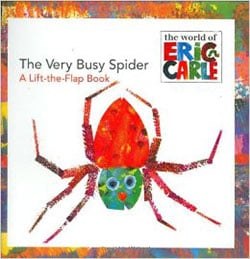 The Very Busy Spider by Eric Carle
The Very Busy Spider by Eric Carle
In contrast to Diddle Daddle Duckling, The Very Busy Spider is easy to find and, if not a classic already, it is fast becoming one.4 It tells the story of a spider who is blown across a field by a strong wind, lands on a farmyard fence post, and begins to spin a web.
While she spins, various farm animals come up and invite her to do something else. The horse, for example, asks the spider if she wants to go for a ride, and the cow asks her if she wants to eat some grass. In each case, the narrator says, “The spider didn’t answer. She was very busy spinning her web.”
Much of the entertainment value of this book, at least at first, comes from hearing or reading the sounds that the animals make when they arrive. The rooster, who crows “Cock-a-doodle-do!,” is the biggest crowd-pleaser in our house. The deeper and longer-lasting value of the book, however, is the joy children (and parents) experience in seeing the spider refuse to be distracted from what she sets out to do, eventually catch a fly in her new web, and settle in to sleep after a very busy day.
Given its similarities to Diddle Daddle Duckling, the book also enables children to see connections between the two heroes—thus starting what may become a lifelong habit of comparing characters in books with each other (and with people in real life).
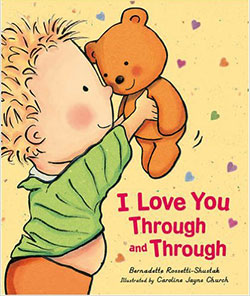 I Love You Through and Through by Bernadette Rossetti-Shustak
I Love You Through and Through by Bernadette Rossetti-Shustak
Not all children’s books are fully as enjoyable for a parent to read as they are for a child to hear, but I Love You Through and Through may be an exception.5
The book’s first line is a repeat of the title, and the lines that follow clarify just what that means. For example, “I love your happy side, your sad side, your silly side, your mad side. I love your fingers and toes, your ears and nose.” And, “I love you through and through . . . yesterday, today, and tomorrow, too.”
The experience of reading this as a parent is pure joy. It feels good to say these things, it is good for your child to hear them, and it makes him or her feel good to boot.
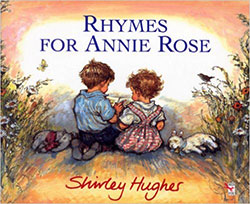 Rhymes for Annie Rose by Shirley Hughes
Rhymes for Annie Rose by Shirley Hughes
There are many good books of poetry for children—for example: Poems to Read to the Very Young, selected by Josette Frank; Ride a Purple Pelican, by Jack Prelutsky; and A Child’s Garden of Verses, by Robert Louis Stevenson. Each of these showcases the power and beauty of poetry in a different way. Some are more playful and more fun to say, others make short stories more dreamlike and more mesmerizing to hear. Our family is particularly fond of Rhymes for Annie Rose.6
The poems in this collection are about the world in which Annie Rose and her big brother, Alfie, live. The illustrations (also by the author) are particularly well done. And the poems are not all written with one meter. Hughes changes both rhythm and rhyme to suit the scene she wants to create. This variety adds to the pleasure of the book and enables a child to experience how just saying something a certain way creates an experience of it. Take, for example, the poem “Cows Graze”:
Cows graze,
Slowly turn their heads to gaze,
With twitching ears and soft brown eyes,
And swishy tails for swishing flies.
Chewing, mooing, chomping grass,
Slowly through the field they pass.
All the lazy summer days,
Cows graze.
This matching of rhythm and rhyme to the various subjects makes for wonderful sounds that connect to the imagery and go straight to the soul. The subjects themselves are easy for a child to relate to as well. They include splashing in the rain, watching clothes dance in a washing machine’s window, and going on a sea adventure . . . in the living room.
The poems in this book do more than match rhythm, rhyme, and subject. Many of the poems also match the wonder and reverence that a child brings to his experience of the world with an adult’s vocabulary and poetic skill. Some of my favorites in this regard are poems on the footprints left by a bird in fresh snow and on the way a garden path at Grandma’s opens up into a “huge world made of grass and sky as far as you can see.” A short example of such poems is the following, titled “Winter Evening”:
One winter evening, time for bed,
One winter evening late,
We heard a bird with a breast of red
Sing by the garden gate.
He cocked his head with its bright black eye
And sang in the still damp air,
And a star came out in a pale yellow sky
And silently twinkled there.
If you liked that, you’ll want to pick up a copy of Rhymes for Annie Rose.
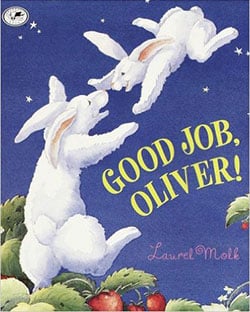 Good Job, Oliver! by Laurel Molk
Good Job, Oliver! by Laurel Molk
Good Job, Oliver! is reminiscent of The Carrot Seed.7 It begins with a bunny named Oliver entering the annual strawberry contest and being told by the biggest bunny that “little bunnies grow little berries.” Like the determined boy with his carrot seed, however, this does not deter Oliver. Nothing does. And Oliver has to contend with much more than belittlement or discouragement from others.
After planting his strawberry seeds near some sunflowers and blueberry bushes, Oliver must figure out how to keep birds from eating them, how to protect the plants from gophers—and then how to protect the strawberries from bears.
Throughout the book, Oliver acts alone, in contrast to the “big bunnies,” who all work together. More importantly, it shows him using his mind. As each new danger presents itself, Oliver realizes he cannot do physically what the big bunnies can. He tells himself, “Think, Oliver, think.” And that’s how he succeeds.
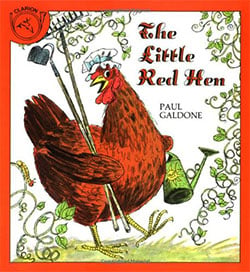 The Little Red Hen by Paul Galdone
The Little Red Hen by Paul Galdone
Sometimes getting things done takes a lot of thought. It requires you to observe what you have and, like Oliver, to figure out a way you can use it to get what you want. Other times, what you need to do is clear, and all that is required is effort.
The Little Red Hen tells the story of “a cat and a dog and a mouse and a little red hen [who] all lived together in a cozy little house.”8 The cat, dog, and mouse like to sleep all day, and the hen does all the housework. One day, the hen finds some grains of wheat, and asks, “Who will plant this wheat?” The cat, dog, and mouse all respond, “Not I.” The hen says, “Then I will,” and, as the narrator tells us, she did.
Like the boy with his carrot seed, each morning the hen waters the wheat and pulls up the weeds around it. When the wheat grows tall, she asks who will cut it. But the chorus remains the same. All three animals say, “Not I.”
The little red hen cuts the wheat, takes it to the mill to be ground into flour, brings it back, and makes a cake with it. When she finishes baking the cake, however, the cat, dog, and mouse come into the kitchen. The hen asks, “Who will eat this cake?” And this time, the chorus is different. All three say, “I will!”
But the hen says, “All by myself I planted the wheat, I tended the wheat, I cut the wheat, I took the wheat to the mill to be ground into flour. All by myself I gathered the sticks, I built the fire, I mixed the cake. And all by myself I am going to eat it!” The narrator then says she did just that, “to the very last crumb.”
The Little Red Hen is true literature for children. It presents a hard-working heroine who asserts her right to the product of her efforts; it tells her story in an interesting way; and it provides children with a rare but beautiful experience in literature: the joy of seeing everyone get what he deserves.
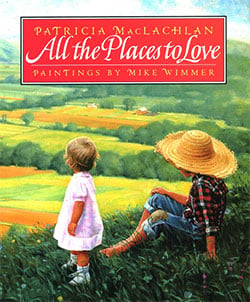 All the Places to Love by Patricia MacLachlan
All the Places to Love by Patricia MacLachlan
All the Places to Love tells the story of a boy named Eli.9 When he is first born, his grandmother wraps him “in a blanket made from the wool of her sheep” and holds him up to the open window so that what he sees first are all the places to love.
As Eli grows up, he learns what his mother’s favorite place is—then his papa’s, grandmother’s, and grandfather’s. He explores the world himself. And eventually his little sister, Sylvie, is born.
Eli takes to the role of big brother quickly and is eager to teach his little sister about the world, just like his family taught him. He says:
Someday I might live in the city. Someday I might live by the sea. But soon I will carry Sylvie on my shoulders through the fields; I will send her messages downriver in small boats; and I will watch her at the top of the hill, trying to touch the sky. I will show her my favorite place, the marsh, where ducklings follow their mother like tiny tumbles of leaves.
All the Places to Love is a beautifully written book about a family who love each other and appreciate how wonderful nature can be. It is also masterfully illustrated by Mike Wimmer. His painting of Eli bending down to inspect an old turtle is especially worthy of praise; in it, Wimmer captures the essence of many curious children the world over and, in a style that is perfectly in sync with the text, he does so in a subtle, reverent way.
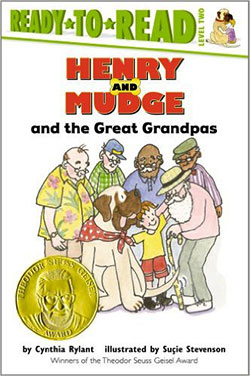 Henry and Mudge and the Great Grandpas by Cynthia Rylant
Henry and Mudge and the Great Grandpas by Cynthia Rylant
Whether an independent young boy, a persistent little duckling, a very busy spider, or a resourceful bunny, a character that your child both relates to and admires is a beautiful thing to find. And then there is the beauty of finding a character that he can enjoy and grow with over a whole series of books. In the Henry and Mudge series, there is more than one such character.
The series focuses on the friendship between Henry and his big dog, Mudge. It tells of their adventures with various friends, Henry’s parents, a cousin named Annie, and, always, with each other. It also does so with short sentences and simple language, so this is a series your child can grow with as a reader, too.
In Henry and Mudge and the Great Grandpas, Henry, Mudge, and Henry’s parents visit Great-Grandpa Bill, who lives in a big house with a lot of other grandpas.10 Like the other adults in the series, these grandpas are good-natured and all smiles.
At the start of the book, after telling us what Henry likes about them and detailing the gifts that Henry brought for them, the narrator says that Henry and Mudge “went looking for adventure.” As usual, the two find it—this time in the form of a pond that Henry, with characteristic excitement, says is “just right for swimming.”
After going back to the house to tell his father about the pond, Henry becomes even more excited. Not only does his father want to swim, the grandpas do too! So they all set out, except Henry’s mother, who stays behind to make spaghetti.
What follows is a typical day for the series. Everyone splashes playfully in the water, Henry’s father makes a silly joke that Henry giggles at, and—over some stories of what the grandfathers used to do—they all rest. “The pond was shiny, the sun was warm, and the grass was soft. Henry and Mudge and everyone there felt happy.”
On the way back, the Grandpas are tired and have to rest on Mudge—who doesn’t mind one bit. Then they all eat spaghetti. “They ate and ate and ate,” we hear. After dinner, everyone sits on the porch in rocking chairs. “And as the sun slowly set, Henry and Mudge rested. Glad for a Grandpa house.”
It is a typical ending, too. Like the other books in the series, chances are your child will finish this book feeling more grateful and more content than ever. Chances are you’ll finish the book feeling so, too.
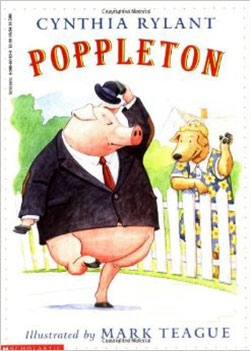 Poppleton by Cynthia Rylant
Poppleton by Cynthia Rylant
Another series of books by Cynthia Rylant revolves around the world of a pig named Poppleton. This series is considered a level higher in terms of what it demands of budding readers. The sentences are longer, and the vocabulary is more advanced. But, like the Henry and Mudge series, the books are consistently good, the characters have their own interests, they enjoy each other’s company, and their various adventures are interesting to read about.
Poppleton is the first book in the series.11 It consists of three short stories, one of which, “The Library,” is a favorite in my house. The title comes from the place that Poppleton likes to go every Monday. As the narrator says:
Monday was always Poppleton’s library day. If Cherry Sue invited him to tea on Monday, Poppleton would say, “Sorry. Library day.” If there was a wonderful parade in town on Monday, Poppleton would say, “Too bad. Library day.” Poppleton took library day very seriously.
Poppleton has a whole routine that he follows at the library, all of it revolving around the adventure book he picks. Most importantly, however, as in the Henry and Mudge books, children get to experience that day with pleasure. And it ends, as in those books, with a scene that leaves them feeling happy.
That is reason enough to share this book. But there’s also a good lesson for children in it. When Poppleton slowly walks home, “all dreamy from so much adventure,” and with a look of pure contentment on his face, children can see that a job is not the only thing worth taking seriously: their own pleasure is, too.
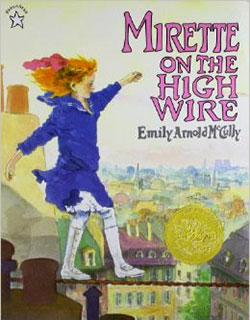 Mirette on the High Wire by Emily Arnold McCully
Mirette on the High Wire by Emily Arnold McCully
Mirette on the High Wire is a complex book in that it involves two separate plot lines that come together at the end.12 It is also quite demanding for new readers. A child who may already be reading some of the other books I’ve recommended may not yet be able to read this one on his or her own. This book is likely to remain on the parent’s read-out-loud list for some time. That said, the book is a pleasure to read, in part because it reminds both old and young alike that one’s job and one’s pleasure aren’t mutually exclusive. They can be one and the same.
The story begins one hundred years ago in a boarding house in Paris, run by the widow Gâteau. The boarding house is popular with acrobats, jugglers, actors, and mimes from all over the world. Mirette is the daughter of Madame Gâteau and, when she is not working hard to help her mother, she loves listening to the acrobats and performers tell of their adventures on the road.
One day, after a sad-faced stranger named Bellini arrives, Mirette goes out to the courtyard to get sheets and sees him several feet in the air on a wire, seemingly walking across the courtyard on air. “Mirette was enchanted. Of all the things a person could do, this must be the most magical. Her feet tingled, as if they wanted to jump up on the wire beside Bellini.”
Naturally, Mirette begs him to teach her how to do it. He tells her it’s not a good idea. She begs him more. He refuses. But Mirette watches him every day. And one day she tries herself, and she fails and fails and fails. “Finally after a week of many, many fails, she walked the length of the wire.” This persistence impresses Bellini, and he consents at last to train her.
The story that follows includes a plot twist involving something Bellini himself must learn, and then another, in which Mirette helps Bellini to solve a harrowing problem by herself stepping onto a wire, and “with the most intense pleasure, as she had always imagined it might be, she started to cross the sky.”
The book is illustrated by the author, and the illustrations are exquisite. Each is a pleasure to look at and enables children to appreciate the complex story more easily and thoroughly than would otherwise be possible.
The book is also a great capstone to all the previous books, for Mirette embodies the characteristics of many of those earlier heroes. She takes her pleasure seriously, like Poppleton does. She is proactive and persistent about getting what she wants, like the Very Busy Spider and Diddle Daddle Duckling. She proves to be a loyal friend, like Henry and Mudge. And she earns her pride and enjoys what she has earned, like the Little Red Hen.
Needless to say, there are many more great books for young children. But these twelve are gems, and if you add them to your library, you and your child will find many hours of pleasure and learning in their pages.
You might also like
Endnotes
1. Margaret Wise Brown, Goodnight Moon (New York: HarperFestival, 2007) p. 31
2. Ruth Krauss, The Carrot Seed (New York: HarperCollins, 2004) p. 32
3. Grace Irene Bennett, Diddle Daddle Duckling (WI: Whitman Publishing Company, 1971) p. 26
4. Eric Carle, The Very Busy Spider (New York: Philomel Books, 1995) p. 30
5. Bernadette Rossetti-Shustak, I Love You Through and Through (New York: Cartwheel, 2005) p. 24
6. Shirley Hughes, Rhymes for Annie Rose (Cambridge, MA: Candlewick, 2006) p. 48
7. Laurel Molk, Good Job, Oliver! (New York: Knopf Books for Young Readers, 1999) p. 40
8. Paul Galdone, The Little Red Hen (New York: HMH Books for Young Readers, 1985) p. 48
9. Patricia MacLachlan, All the Places to Love (New York: HarperCollins, 1994) p. 32
10. Cynthia Rylant, Henry and Mudge and the Great Grandpas (New York: Simon Spotlight, 2006) p. 40
11. Cynthia Rylant, Poppleton (New York: Blue Sky Press, 1997) p. 56
12. Emily Arnold McCully, Mirette on the High Wire (New York: Puffin Books, 1997) p. 32


![[TEST] The Objective Standard](https://test.theobjectivestandard.com/wp-content/uploads/2017/10/logo.png)












